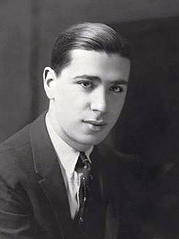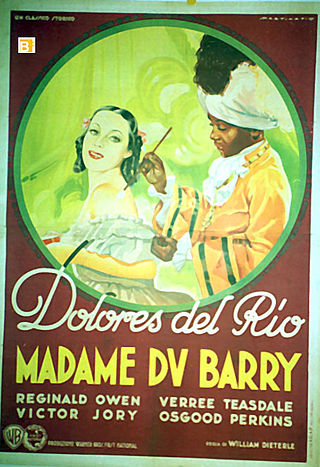
Edward Kennedy "Duke" Ellington was an American jazz pianist, composer, and leader of his eponymous jazz orchestra from 1923 through the rest of his life.

Mary Jane "Mae" West was an American actress, singer, comedian, screenwriter, and playwright whose career spanned over seven decades. Considered a sex symbol, she was known for her breezy sexual independence and her lighthearted bawdy double entendres, often delivered in a husky contralto voice. She was active in vaudeville and on stage in New York City before moving to Los Angeles to begin a career in the film industry.

George Raft was an American film actor and dancer identified with portrayals of gangsters in crime melodramas of the 1930s and 1940s. A stylish leading man in dozens of movies, Raft is remembered for his gangster roles in Quick Millions (1931) with Spencer Tracy, Scarface (1932) with Paul Muni, Each Dawn I Die (1939) with James Cagney, Invisible Stripes (1939) with Humphrey Bogart, and Billy Wilder's comedy Some Like It Hot (1959) with Marilyn Monroe and Jack Lemmon; and as a dancer in Bolero (1934) with Carole Lombard and a truck driver in They Drive by Night (1940) with Ann Sheridan, Ida Lupino and Bogart.

Sam Coslow was an American songwriter, singer, film producer, publisher and market analyst. Coslow was born in New York City. He began writing songs as a teenager. He contributed songs to Broadway revues, formed the music publishing company Spier and Coslow with Larry Spier and made a number of recordings as a performer.

Madame DuBarry is a 1934 American historical film directed by William Dieterle and starring Dolores del Río, Reginald Owen, Victor Jory and Osgood Perkins. The film portrays the life of Madame Du Barry, the last mistress of King Louis XV of France. While this film does not serve accuracy to Madame Du Barry, it does feature antiques and jewelry that came from the actual days when Madame Du Barry lived. This film was being edited just as the Hollywood Production Code was gaining real power, and faced many problems with censors of the time. A May 27, 1934, New York Times column, “Studio Activities on the Western Front”, focusing on the “cracking down” of censors noted that a reel and a half had already been cut from the film, including a bedroom scene.

Mae Marsh was an American film actress whose career spanned over 50 years.

Night After Night is a 1932 American pre-Code drama film starring George Raft, Constance Cummings, and Mae West in her first movie role. Others in the cast include Wynne Gibson, Alison Skipworth, Roscoe Karns, Louis Calhern, and Bradley Page. Directed by Archie Mayo, it was adapted for the screen by Vincent Lawrence and Kathryn Scola, based on the Cosmopolitan magazine story Single Night by Louis Bromfield, with West allowed to contribute to her lines of dialogue.

The Bowery is a 1933 American pre-Code Epic historical drama film set in the Lower East Side of Manhattan around the start of the 20th century directed by Raoul Walsh and starring Wallace Beery and George Raft. The supporting cast features Jackie Cooper, Fay Wray, and Pert Kelton.

Follow the Boys also known as Three Cheers for the Boys is a 1944 musical film made by Universal Pictures during World War II as an all-star cast morale booster to entertain the troops abroad and the civilians at home. The film was directed by A. Edward "Eddie" Sutherland and produced by Charles K. Feldman. The movie stars George Raft and Vera Zorina and features Grace McDonald, Charles Grapewin, Regis Toomey and George Macready. At one point in the film, Orson Welles saws Marlene Dietrich in half during a magic show. W.C. Fields, in his first movie since 1941, performs a classic pool-playing presentation he first developed in vaudeville four decades earlier in 1903.

Limehouse Blues is a 1934 American crime film, directed by Alexander Hall. The film is set in the Limehouse district in the East End of London and its Chinatown. Among the stars of the film were George Raft and Anna May Wong. The film is named after the song "Limehouse Blues".

Lulu White was a brothel madam, procuress and entrepreneur in New Orleans, Louisiana during the Storyville period. An eccentric figure, she was noted for her love of jewelry, her many failed business ventures, and her criminal record that extended in New Orleans as far back as 1880.

Four Hours to Kill! is a 1935 American drama film directed by Mitchell Leisen and starring Richard Barthelmess.

Little Big Shot is a 1935 American film directed by Michael Curtiz and starring Sybil Jason and Glenda Farrell. The film was released by Warner Bros. on September 7, 1935. The plot concerns a young girl who endears herself to her caretakers after her father is murdered by mobsters.

The period from the end of the First World War until the start of the Depression in 1929 is known as the "Jazz Age". Jazz had become popular music in America, although older generations considered the music immoral and threatening to cultural values. Dances such as the Charleston and the Black Bottom were very popular during the period, and jazz bands typically consisted of seven to twelve musicians. Important orchestras in New York were led by Fletcher Henderson, Paul Whiteman and Duke Ellington. Many New Orleans jazzmen had moved to Chicago during the late 1910s in search of employment; among others, the New Orleans Rhythm Kings, King Oliver's Creole Jazz Band and Jelly Roll Morton recorded in the city. However, Chicago's importance as a center of jazz music started to diminish toward the end of the 1920s in favor of New York.

Heart of a Woman is the twenty-third studio album by Etta James released in June 1999 by RCA Records. The album consists of eleven love songs from her favorite female singers as well as a recording of her most popular song, "At Last". Recorded in March 1999, Heart of a Woman was produced by James and John Snyder with Lupe DeLeon as executive producer. James' two sons Donto and Sametto served as assistant producers. Guest musicians appearing on the album include Mike Finnigan, Red Holloway, and Jimmy Zavala. Critical reception of Heart of a Woman was mixed. The album peaked at number four on the Top Blues Albums chart of Billboard magazine.
This is a list of notable events in music that took place in the year 1934.

The Farmer Takes a Wife is a 1935 American romantic comedy film directed by Victor Fleming, written by Edwin J. Burke, and starring Janet Gaynor, Henry Fonda and Charles Bickford. It is based on the 1934 Broadway play The Farmer Takes a Wife by Marc Connelly and Frank B. Elser, with Fonda reprising his stage role as the farmer. The film was released on August 2, 1935, by 20th Century-Fox.

Annie Ross Sings a Song with Mulligan! is an album by vocalist Annie Ross with jazz saxophonist and bandleader Gerry Mulligan featuring performances recorded in 1957 and 1958 which were released on the World Pacific label.
Molly and Mack is a British children's television series that began airing on CBeebies in 2018. It ran for five seasons.
"My Old Flame" is a 1934 song composed by Arthur Johnston with lyrics by Sam Coslow for the film Belle of the Nineties. It has since become a jazz standard.

















